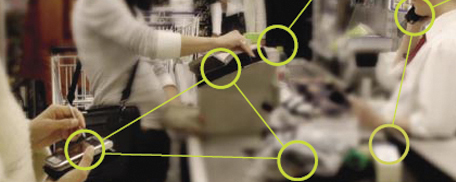Tentative program
Parallel Session 29th of June - Designing for Palpability
15.45 - 16.00 Reliable Communication with RASCAL
Dominic Greenwood
Whitestein Technologies, Zurich, Switzerland
16.00 – 16.15 Composing assemblies in PalCom
Boris Magnusson and David Svensson
Computer Science Department, Lund University, Sweden
This talk will describe how existing Palcom-enabled devices can be put together to form new constellations offering new combined functionality. A simple example is a Digital Camera and a GPS combined to provide a Digital Camera producing GPS-tagged images. Such combinations of existing devices can in PalCom be created without changing the existing devices, but the combination is put in an "Assembly", a concept that is more like an elaborate cable than an individual device.
The talk will include a demo of how an Assembly can be interactively created by combining services from existing devices (such as a Digital Camera and a GPS).
16.15 – 16.30 Designing for material practice: Supporting emergency teamwork
Monika Busher, Lancaster University
In this talk I describe the inspiration for, and the design of, prototype technologies that support emergency teamwork. Emergency response work is characterized by extreme mobilities and material practices of 'place-making' in often chaotic circumstances. We seek to enable professionals to realize the potential of ubiquitous computing technologies to ‘stretch’ the materiality of environments, persons and equipment. Key to this is that professionals can notice and understand what technologies are doing and /could /do for them. This means, they must be able to make computing 'palpable'. Drawing on ethnographic studies of material practice, and participatory design collaboration with emergency personnel, my colleagues and I design prototype devices, services, and contribute to the design of the PalCom open architecture, to support the assembly of future ubiquitous computing technologies in the context of emergency response work.
16.30 – 17.00 Coffee Break
17.00 - 17.15 Tecnologies for unobtrusive monitoring of biosignal
Giuseppe Andreoni, Milan Polytechnic
Giuseppe Andreoni will present the use of the BioBelt in the incubator system
17.15- 17.30 Active Surfaces: rehabilitation in the swimming pool
Erik Grönvall, Patrizia Marti, Alessandro Pollini, Alessia Rullo
Communication Science Department, Siena University, Italy
Active Surfaces is the prototype of a modular system of interactive tiles to support therapists in performing rehabilitation activities for impaired children in a swimming pool. Active Surfaces can be configured and assembled on-the-fly by the therapists according to different disabilities, usage, physical space and exercises’ complexity. Once assembled the tiles constitute a network of physical and software objects that communicate and exchange data. These assemblies allow dynamic physical programming and inspection of the services running on each tile. In this way the therapists can control the current system and have means to overcome functional breakdown situations. The tiles act as building blocks and have different reactive behaviors in relation to the environmental changes including different input from the users. Each tile provides a visual, acoustic or tactile feedback, this in order to aid the patient accomplishing

